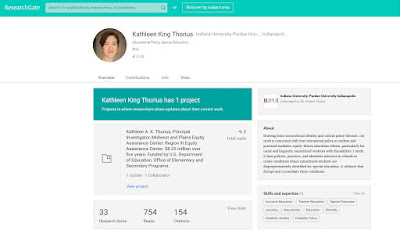Barb Novak contributed this post.
Click here for more of Barb's thinking.
Click here for more Literacy Booth thoughts about research.
Note. I'm sharing this article simply to give access to how I process when I read from academic journals - how I organize my thinking before, during, and after reading. This post is not intended to be an endorsement of the research or its conclusions.
"Stimulating tensions in special education teachers' figured world: An approach toward inclusive education"
Kathleen A.K. Thorius in International Journal of Inclusive Education (2016)
I accessed the article (full-text free of charge) from Thorius's page on ResearchGate.
Why this article?
I worked with Thorius on a project about identifying high leverage literacy practices for students with disabilities. I respect her strengths-based approach to professional learning and emphasis on collaborative sense-making as part of a change process.
Research Questions:
Research Questions:
Thorius introduced "artifacts" during professional learning sessions and reviewed transcripts from the sessions to understand:
- how "the figured world of special educator participants emerge and shift over time" (p. 1329)
- how artifacts "contribute to the creation of tensions and related shifts in this figured world" (p. 1329)
Important Terms:
- Figured worlds: Holland's theory (1998) that "people figure their identities through participating in activities and social relationships with others" (p. 1328). People construct an understanding of who they are and behave according to these understandings.
- Artifacts: Objects with mediate identity formation.
Methods:
Thorius facilitated seven weekly teacher learning sessions (1.5 hours each). Participants were drawn from "two schools in a large Midwestern urban school district" (p. 1329). All participants were female. Two identified as general educators; four identified as special educators. All worked between kindergarten and grade six.
Each teacher learning session included:
- a debrief of the previous session led by the research team,
- presentation of an artifact developed or selected based on progress in the previous session
- engagement with the artifact
- homework (application within the classroom)
Artifacts pushed thinking about inclusive education and universal design for learning (UDL).
Thorius and the research team recorded and transcribed the teacher learning sessions and analyzed the transcripts for evidence of figured worlds.
Main Points:
Special educators who participated in the learning sessions initially viewed themselves as "remediators" and "diagnosticians" (p. 1332). This led to a "desire to learn 'tricks' to fix students" (p. 1333) and a belief that a student's diagnosis "explained student patterns of competence and. . . suggested a prescription for remediation" (p. 1333).
Artifacts introduced in the learning sessions did produce tensions and identity shifts. Some tensions were related to relationships with general education colleagues. Specifically, tensions surfaced about how special educators "were physically and professional positioned by and in comparison to their general education coutnerparts (p. 1335). Participants also realized they needed to be "critical examiners of structural barriers" that may prevent them from applying their learning.
The sample size for the study was small (6 participants from two schools in the same district).
Discussion:
Thorius's article has implications for planning and facilitating professional learning:
- How can reflection be included in professional learning in order to consider how one's identity is shifting?
- How can sequential opportunities for learning be adjusted to meet the needs of the participants (rather than strictly following a set plan)?
- How can professional learning promote change within classrooms but also within a system? How can professional learning position educators as change agents for their system?
Full Citation:
Thorius, K.A.K. (2016). Stimulating tensions in special education teachers' figured world: An approach toward inclusive education. Interntional Journal of Inclusive Education 20(12), 1326 - 1343. doi: http://dx.doi.org/10.1080/13603116.2016.1168877



No comments:
Post a Comment
Comments are moderated. Your comment will appear after approval by this blog's editor.